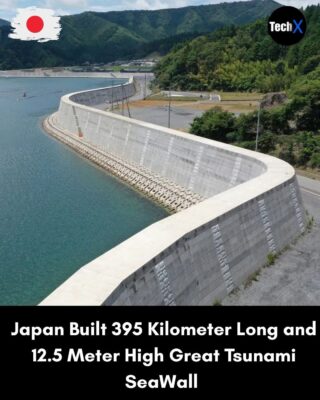
Japan’s 365-Kilometer Tsunami Wall: A Monumental Defense Against the Sea
In the aftermath of the 2011 Tohoku earthquake and tsunami that ravaged Japan’s northeastern coast, the country embarked on an ambitious project to safeguard its future. The devastating disaster claimed thousands of lives and left a trail of destruction in its wake. In response, Japan’s government conceptualized and initiated the construction of a colossal tsunami wall, stretching an impressive 365 kilometers (about 227 miles) along the Pacific coastline. This gargantuan barrier is designed to protect the country from the fury of future tsunamis.
The Engineering Marvel
The tsunami wall, in some areas towering over 12 meters (about 39 feet) high, is an engineering feat that showcases Japan’s technological prowess. Constructed with reinforced concrete and steel, this wall is designed to withstand the immense force of tsunami waves. The wall’s design takes into account the region’s unique geography, with sections built to accommodate varying wave heights and coastal features.
Impact on Communities and the Environment
While the wall’s primary purpose is to protect human life and infrastructure, its construction has not been without controversy. Local communities have raised concerns about the wall’s impact on the natural beauty of the coastline and the potential disruption to marine ecosystems. Some have also questioned the wall’s effectiveness in mitigating tsunami damage, citing the complexity of predicting wave behavior and the potential for waves to overtop or breach the barrier.
A Symbol of Resilience
Despite these concerns, the 365-kilometer tsunami wall stands as a testament to Japan’s determination to safeguard its people and its future. The wall’s construction is a reflection of the country’s commitment to disaster preparedness and its willingness to invest in innovative solutions to mitigate the impact of natural disasters.
Conclusion
Japan’s tsunami wall is an awe-inspiring example of engineering ingenuity and a powerful symbol of the country’s resilience in the face of adversity. As the world grapples with the challenges posed by climate change and rising sea levels, Japan’s tsunami wall serves as a model for other nations seeking to protect their coastlines and communities from the fury of the sea.
Japan’s 365-Kilometer Tsunami Wall: A Monumental Defense Against the Sea
In the aftermath of the 2011 Tohoku earthquake and tsunami that ravaged Japan’s northeastern coast, the country embarked on an ambitious project to safeguard its future. The devastating disaster claimed thousands of lives and left a trail of destruction in its wake. In response, Japan’s government conceptualized and initiated the construction of a colossal tsunami wall, stretching an impressive 365 kilometers (about 227 miles) along the Pacific coastline. This gargantuan barrier is designed to protect the country from the fury of future tsunamis.
The Engineering Marvel
The tsunami wall, in some areas towering over 12 meters (about 39 feet) high, is an engineering feat that showcases Japan’s technological prowess. Constructed with reinforced concrete and steel, this wall is designed to withstand the immense force of tsunami waves. The wall’s design takes into account the region’s unique geography, with sections built to accommodate varying wave heights and coastal features.
Impact on Communities and the Environment
While the wall’s primary purpose is to protect human life and infrastructure, its construction has not been without controversy. Local communities have raised concerns about the wall’s impact on the natural beauty of the coastline and the potential disruption to marine ecosystems. Some have also questioned the wall’s effectiveness in mitigating tsunami damage, citing the complexity of predicting wave behavior and the potential for waves to overtop or breach the barrier.
A Symbol of Resilience
Despite these concerns, the 365-kilometer tsunami wall stands as a testament to Japan’s determination to safeguard its people and its future. The wall’s construction is a reflection of the country’s commitment to disaster preparedness and its willingness to invest in innovative solutions to mitigate the impact of natural disasters.
Conclusion
Japan’s tsunami wall is an awe-inspiring example of engineering ingenuity and a powerful symbol of the country’s resilience in the face of adversity. As the world grapples with the challenges posed by climate change and rising sea levels, Japan’s tsunami wall serves as a model for other nations seeking to protect their coastlines and communities from the fury of the sea.



